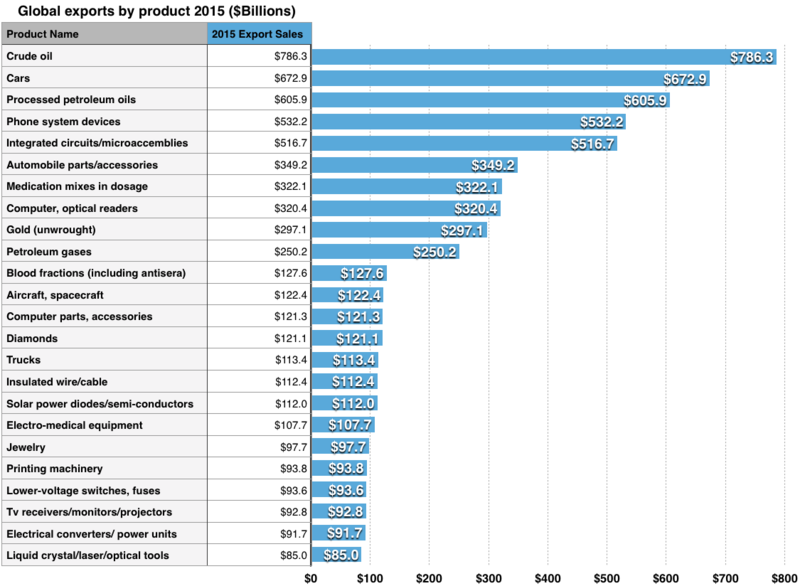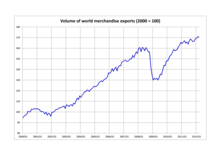International trade
hideThis article has multiple issues. Please help or discuss these issues on the talk page. (Learn how and when to remove these template messages)
|
| Part of a series on |
| World trade |
|---|
 |
International trade is the exchange of capital, goods, and services across international borders or territories[1] because there is a need or want of goods or services.[2]
In most countries, such trade represents a significant share of gross domestic product (GDP). While international trade has existed throughout history (for example Uttarapatha, Silk Road, Amber Road, scramble for Africa, Atlantic slave trade, salt roads), its economic, social, and political importance has been on the rise in recent centuries.
Carrying out trade at an international level is a complex process when compared to domestic trade. When trade takes place between two or more states factors like currency, government policies, economy, judicial system, laws, and markets influence trade.
To ease and justify the process of trade between countries of different economic standing in the modern era, some international economic organizations were formed, such as the World Trade Organization. These organizations work towards the facilitation and growth of international trade. Statistical services of intergovernmental and supranational organizations and governmental statistical agencies publish official statistics on international trade.
Characteristics of global trade[]
A product that is transferred or sold from a party in one country to a party in another country is an export from the originating country, and an import to the country receiving that product. Imports and exports are accounted for in a country's current account in the balance of payments.[3]
Trading globally may give consumers and countries the opportunity to be exposed to new markets and products. Almost every kind of product can be found in the international market, for example: food, clothes, spare parts, oil, jewellery, wine, stocks, currencies, and water. Services are also traded, such as in tourism, banking, consulting, and transportation.
Advanced technology (including transportation), globalization, industrialization, outsourcing and multinational corporations have major impacts on the international trade system.
Differences from domestic trade[]

International trade is, in principle, not different from domestic trade as the motivation and the behavior of parties involved in a trade do not change fundamentally regardless of whether trade is across a border or not.
However, in practical terms, carrying out trade at an international level is typically a more complex process than domestic trade. The main difference is that international trade is typically more costly than domestic trade. This is due to the fact that a border typically imposes additional costs such as tariffs, time costs due to border delays, and costs associated with country differences such as language, the legal system, or culture (non-tariff barriers).
Another difference between domestic and international trade is that factors of production such as capital and labor are often more mobile within a country than across countries. Thus, international trade is mostly restricted to trade in goods and services, and only to a lesser extent to trade in capital, labour, or other factors of production. Trade in goods and services can serve as a substitute for trade in factors of production. Instead of importing a factor of production, a country can import goods that make intensive use of that factor of production and thus embody it. An example of this is the import of labor-intensive goods by the United States from China. Instead of importing Chinese labor, the United States imports goods that were produced with Chinese labor. One report in 2010, suggested that international trade was increased when a country hosted a network of immigrants, but the trade effect was weakened when the immigrants became assimilated into their new country.[4]
History[]
The history of international trade chronicles notable events that have affected trading among various economies.
Theories and models[]
There are several models that seek to explain the factors behind international trade, the welfare consequences of trade and the pattern of trade.
Most traded export products[]

Largest countries by total international trade[]

The following table is a list of the 21 largest trading states according to the World Trade Organization.[5][failed verification]
| Rank | State | International trade of goods (billions of USD) |
International trade of services (billions of USD) |
Total international trade of goods and services (billions of USD) |
|---|---|---|---|---|
| – | World | 32,430 | 9,635 | 42,065 |
| – | 3,821 | 1,604 | 5,425 | |
| 1 | 3,706 | 1,215 | 4,921 | |
| 2 | 3,686 | 656 | 4,342 | |
| 3 | 2,626 | 740 | 3,366 | |
| 4 | 1,066 | 571 | 1,637 | |
| 5 | 1,250 | 350 | 1,600 | |
| 6 | 1,074 | 470 | 1,544 | |
| 7 | 1,073 | 339 | 1,412 | |
| 8 | 1,064 | 172 | 1,236 | |
| 9 | 902 | 201 | 1,103 | |
| 10 | 866 | 200 | 1,066 | |
| 11 | 807 | 177 | 984 | |
| 12 | 763 | 212 | 975 | |
| 13 | 623 | 294 | 917 | |
| 13 | 613 | 304 | 917 | |
| 15 | 771 | 53 | 824 | |
| 16 | 596 | 198 | 794 | |
| 17 | 572 | 207 | 779 | |
| 18 | 511 | 93 | 604 | |
| 19 | 473 | 122 | 595 | |
| 20 | 248 | 338 | 586 | |
| 21 | 491 | 92 | 583 |
Top traded commodities by value (exports)[]
| Rank | Commodity | Value in US$('000) | Date of information |
|---|---|---|---|
| 1 | Mineral fuels, oils, distillation products, etc. | $2,183,079,941 | 2015 |
| 2 | Electrical, electronic equipment | $1,833,534,414 | 2015 |
| 3 | Machinery, nuclear reactors, boilers, etc. | $1,763,371,813 | 2015 |
| 4 | Vehicles (excluding railway) | $1,076,830,856 | 2015 |
| 5 | Plastics and articles thereof | $470,226,676 | 2015 |
| 6 | Optical, photo, technical, medical, etc. apparatus | $465,101,524 | 2015 |
| 7 | Pharmaceutical products | $443,596,577 | 2015 |
| 8 | Iron and steel | $379,113,147 | 2015 |
| 9 | Organic chemicals | $377,462,088 | 2015 |
| 10 | Pearls, precious stones, metals, coins, etc. | $348,155,369 | 2015 |
Source: International Trade Centre[7]
Observances[]
In the United States, the various U.S. Presidents have held observances to promote big and small companies to be more involved with the export and import of goods and services. President George W. Bush observed World Trade Week on May 18, 2001, and May 17, 2002.[8][9] On May 13, 2016, President Barack Obama proclaimed May 15 through May 21, 2016, World Trade Week, 2016.[10] On May 19, 2017, President Donald Trump proclaimed May 21 through May 27, 2017, World Trade Week, 2017.[11][12] World Trade Week is the third week of May. Every year the President declares that week to be World Trade Week.[13][14]
International trade versus local production[]
Local food[]
In the case of food production trade-offs in forms of local food and distant food production are controversial with limited studies comparing environmental impact and scientists cautioning that regionally specific environmental impacts should be considered.[15] Effects of local food on greenhouse gas emissions may vary per origin and target region of the production. A 2020 study indicated that local food crop production alone cannot meet the demand for most food crops with "current production and consumption patterns" and the locations of food production at the time of the study for 72–89% of the global population and 100–km radiuses as of early 2020.[16][17][18] Studies found that food miles are a relatively minor factor of carbon emissions, albeit increased food localization may also enable additional, more significant, environmental benefits such as recycling of energy, water, and nutrients.[19] For specific foods regional differences in harvest seasons may make it more environmentally friendly to import from distant regions than more local production and storage or local production in greenhouses.[20]
Qualitative differences and economic aspects[]
Qualitative differences between substitutive products of different production regions may exist due to different legal requirements and quality standards or different levels of controllability by local production- and governance-systems which may have aspects of security beyond resource security, environmental protection, product quality and product design and health. The process of transforming supply as well as labor rights may differ as well.
Local production has been reported to increase local employment in many cases. A 2018 study claimed that international trade can increase local employment.[21] A 2016 study found that local employment and total labor income in both manufacturing and nonmanufacturing were negatively affected by rising exposure to imports.[22]
Local production in high-income countries, rather than distant regions may require higher wages for workers. Higher wages incentivize automation[23] which could allow for automated workers' time to be reallocated by society and its economic mechanisms or be converted into leisure-like time.
Specialization, production efficiency and regional differences[]
Local production may require knowledge transfer, technology transfer and may not be able to compete in efficiency initially with specialized, established industries and businesses, or in consumer demand without policy measures such as eco-tariffs. Regional differences may cause specific regions to be more suitable for specific production, thereby increasing advantages of specific trade over specific local production. Forms of local production that are highly localized may not be able to meet the efficiency of more large-scale, highly consolidated production in terms of efficiency, including of environmental impact.[citation needed]
Resource security[]
A systematic, and possibly first large-scale, cross-sectoral analysis of water, energy and land in security in 189 countries that links total and sectorial consumption to sources showed that countries and sectors are highly exposed to over-exploited, insecure, and degraded such resources with economic globalization having decreased security of global supply chains. The 2020 study finds that most countries exhibit greater exposure to resource risks via international trade – mainly from remote production sources – and that diversifying trading partners is unlikely to help countries and sectors to reduce these or to improve their resource self-sufficiency.[24][25][26][27]
See also[]
- Aggressive legalism
- Export control
- Free trade
- Free-trade area
- Gravity model of trade
- Import (international trade)
- Interdependence
- International business
- International trade law
- Internationalization
- Market Segmentation Index
- Mercantilism
- Monopolistic competition in international trade
- Northwest Passage
- Panama Canal
- Suez Canal
- Tariff
- Trade Adjustment Assistance
- Trade bloc
- Trade finance
- United Nations Conference on Trade and Development (UNCTAD)
- Lists
- List of countries by current account balance
- List of countries by imports
- List of countries by exports
- List of international trade topics
Notes[]
- ^ "Trade – Define Trade at Dictionary.com". Dictionary.com.
- ^ International Trade and Finance by ICC Academy
- ^ Staff, Investopedia (2003-11-25). "Balance Of Payments (BOP)". Investopedia. Retrieved 2017-05-07.
- ^ Kusum Mundra (October 18, 2010). "Immigrant Networks and U.S. Bilateral Trade: The Role of Immigrant Income". papers.ssrn. SSRN 1693334.
Mundra, Kusum, Immigrant Networks and U.S. Bilateral Trade: The Role of Immigrant Income. IZA Discussion Paper No. 5237. Available at SSRN: http://ssrn.com/abstract=1693334 ... this paper finds that the immigrant network effect on trade flows is weakened by the increasing level of immigrant assimilation.
- ^ Leading merchandise exporters and importers, 2016
- ^ excluding intra-EU trade
- ^ International Trade Centre (ITC). "Trade Map - Trade statistics for international business development".
- ^ Office of the Press Secretary (May 22, 2001). "World Trade Week, 2001". Federal Register. Washington, D.C.: Federal Government of the United States. Archived from the original on November 24, 2016. Retrieved March 13, 2017. Alt URL
- ^ Office of the Press Secretary (May 22, 2002). "World Trade Week, 2002". Federal Register. Washington, D.C.: Federal Government of the United States. Archived from the original on March 13, 2017. Retrieved March 12, 2017. Alt URL
- ^ "Presidential Proclamation -- World Trade Week, 2016". whitehouse.gov. Washington, D.C. May 13, 2016. Retrieved April 11, 2017 – via National Archives.
- ^ Office of the Press Secretary (May 19, 2017). "President Donald J. Trump Proclaims May 21 through May 27, 2017, as World Trade Week". whitehouse.gov. Washington, D.C.: White House. Archived from the original on May 20, 2017. Retrieved May 20, 2017.
- ^ "President Donald J. Trump Proclaims May 21 through May 27, 2017, as World Trade Week". World News Network. United States: World News Inc. May 20, 2017. Retrieved May 20, 2017.
- ^ "Import Export Data". Import Export data. Retrieved 2017-10-06.
- ^ "World Trade Week New York". World Trade Week New York. Retrieved 2017-10-06.
- ^ Rothwell, Alison; Ridoutt, Brad; Page, Girija; Bellotti, William (15 February 2016). "Environmental performance of local food: trade-offs and implications for climate resilience in a developed city". Journal of Cleaner Production. 114: 420–430. doi:10.1016/j.jclepro.2015.04.096. ISSN 0959-6526. Retrieved 4 December 2020.
- ^ Dunphy, Siobhán (28 April 2020). "Majority of the world's population depends on imported food". European Scientist. Retrieved 17 May 2020.
- ^ "Relying on 'local food' is a distant dream for most of the world". phys.org. Retrieved 17 May 2020.
- ^ Kinnunen, Pekka; Guillaume, Joseph H. A.; Taka, Maija; D’Odorico, Paolo; Siebert, Stefan; Puma, Michael J.; Jalava, Mika; Kummu, Matti (April 2020). "Local food crop production can fulfil demand for less than one-third of the population". Nature Food. 1 (4): 229–237. doi:10.1038/s43016-020-0060-7.
- ^ Yang, Yi; Campbell, J. Elliott (1 March 2017). "Improving attributional life cycle assessment for decision support: The case of local food in sustainable design". Journal of Cleaner Production. 145: 361–366. doi:10.1016/j.jclepro.2017.01.020. ISSN 0959-6526. Retrieved 4 December 2020.
- ^ Edwards-Jones, Gareth (2010). "Does eating local food reduce the environmental impact of food production and enhance consumer health?". Proceedings of the Nutrition Society. 69 (4): 582–591. doi:10.1017/S0029665110002004. ISSN 1475-2719. PMID 20696093. Retrieved 4 December 2020.
- ^ Wang, Zhi; Wei, Shang-Jin; Yu, Xinding; Zhu, Kunfu (13 August 2018). "Re-examining the Effects of Trading with China on Local Labor Markets: A Supply Chain Perspective". National Bureau of Economic Research. Retrieved 4 December 2020. Cite journal requires
|journal=(help) - ^ Malgouyres, Clément (2017). "The Impact of Chinese Import Competition on the Local Structure of Employment and Wages: Evidence from France". Journal of Regional Science. 57 (3): 411–441. doi:10.1111/jors.12303. ISSN 1467-9787. S2CID 56047849. Retrieved 4 December 2020.
- ^ "How Artificial Intelligence Could Widen the Gap Between Rich and Poor Nations". IMF Blog. Retrieved 4 December 2020.
Higher wages Advanced economies have higher wages because total factor productivity is higher. These higher wages induce firms in advanced economies to use robots more intensively to begin with, especially when robots easily substitute for workers. Then, when robot productivity rises, the advanced economy will benefit more in the long run. This divergence grows larger, the more robots substitute for workers.
- ^ "Global trade linked to resource insecurity". Cosmos Magazine. 26 October 2020. Retrieved 3 December 2020.
- ^ Dunphy, Siobhán (20 November 2020). "Is globalisation compatible with sustainable and resilient supply chains?". European Scientist. Retrieved 3 December 2020.
- ^ "Globalized economy making water, energy and land insecurity worse: study". phys.org. Retrieved 3 December 2020.
- ^ Taherzadeh, Oliver; Bithell, Mike; Richards, Keith (28 October 2020). "Water, energy and land insecurity in global supply chains". Global Environmental Change: 102158. doi:10.1016/j.gloenvcha.2020.102158. ISSN 0959-3780. Retrieved 3 December 2020.
References[]
- Jones, Ronald W. (1961). "Comparative Advantage and the Theory of Tariffs". The Review of Economic Studies. 28 (3): 161–175. doi:10.2307/2295945. JSTOR 2295945.
- McKenzie, Lionel W. (1954). "Specialization and Efficiency in World Production". The Review of Economic Studies. 21 (3): 165–180. doi:10.2307/2295770. JSTOR 2295770.
- Samuelson, Paul (2001). "A Ricardo-Sraffa Paradigm Comparing the Gains from Trade in Inputs and Finished Goods". Journal of Economic Literature. 39 (4): 1204–1214. doi:10.1257/jel.39.4.1204.
External links[]
Data[]
Statistics from intergovernmental sources[]
Data on the value of exports and imports and their quantities often broken down by detailed lists of products are available in statistical collections on international trade published by the statistical services of intergovernmental and supranational organisations and national statistical institutes. The definitions and methodological concepts applied for the various statistical collections on international trade often differ in terms of definition (e.g. special trade vs. general trade) and coverage (reporting thresholds, inclusion of trade in services, estimates for smuggled goods and cross-border provision of illegal services). Metadata providing information on definitions and methods are often published along with the data.
- United Nations Commodity Trade Database
- Trade Map, trade statistics for international business development
- WTO Statistics Portal
- Statistical Portal: OECD
- European Union International Trade in Goods Data
- Food and Agricultural Trade Data by FAO
Other data sources[]
- Resources for data on trade, including the gravity model
- Asia-Pacific Trade Agreements Database (APTIAD)
- Asia-Pacific Research and Training Network on Trade (ARTNeT)
- World Integrated Trade Solution (WITS)
- Market Access Map, an online database of customs tariffs and market requirements
- Trade Data Monitor, a database of monthly import/export statistics for all countries and commodities (subscription required)
- ExportNation Trade Statistics
- Export Port and Product List
Other external links[]
- The Observatory of Economic Complexity
- The McGill Faculty of Law runs a Regional Trade Agreements Database that contains the text of almost all preferential and regional trade agreements in the world. ptas.mcgill.ca
- Historical documents on international trade available on FRASER
- International trade
- Official statistics

